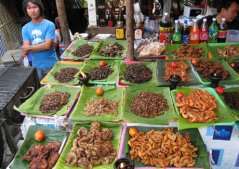Thesis subject
Production and consumption of novel protein foods: Insects.
Topic 1. Healthiness of edible insects: nutrient profiling.
Commercial farming, processing and marketing of edible insects are hot issues now because of sustainable potential. In general, the reproduction of insects is less time-consuming compared to conventional livestock (e.g. pig, cattle). Moreover, a potential shift of human diets from animal meat to insects has beneficial impacts on environment and ecosystem. Consuming insects could contribute in solving the increasing requirement of high-value protein globally. As a possible replacement of animal protein, edible insects can be progressively served up for human consumption.
Consumers like their food to be healthy. Currently there is little insight into overall healthiness of edible insects. In most cases, each insect nutrient was evaluated individually; a healthiness comparison between insects and conventional food groups was neither comprehensive nor systematic. Without powerful nutrition and health claims, consumers have no clear idea about the healthiness of insect-based foods.
To help the public make more healthful food choices, the latest American dietary recommendations -2010 Dietary Guidelines for Americans- underlined the use of the nutrient density concept, and approved of nutrient-dense foods and beverages which contributed to achieving and maintaining a healthy weight (USDA and HHS, 2010). In fact, nutrient density deals with the principle of “the amount of nutrients per calorie”. In France, according to the national program on nutrition and health (PNNS), the nutrient density of a food corresponds to its content of essential micronutrients in relation to its energy value. In the United States, according to the United States Department of Agriculture (USDA) and the US Department of Health and Human Services (HHS), nutrient-dense foods offer vitamins, minerals, and other substances that may have positive health effects, with comparatively few calories. Consuming nutrient-dense foods enables people to achieve nutrition goals without exceeding daily energy requirement, which is more beneficial to human health. In this sense, nutrient density can be a good indicator for food healthiness; a higher nutrient density manifests more nutrient-dense and more healthful the food is.
In order to assess nutrient density different nutrient profiling systems are used in literature. Nutrient profiling aims at ranking foods based on their nutrient content as opposite to their energy content. The research will aim at gathering nutrient data of specific insect species, and ranking them for nutrient density using appropriate nutrient profiling systems. Comparisons will be made with traditional and novel protein sources/products. The approach taken will be from a Q-design perspective.

For more information please contact Catriona Lakemond.
Topic 2. Towards a sustainable insect production chain.
Insects are considered to be a future alternative protein source. Literature supports that rearing insects is sustainable in comparison to traditional meat sources. Insects are already offered as a whole on the market. Another foreseen development is bio fractionation of insects into a protein, a fat and a chitin rich fraction. In order to be able to offer insect fractions as being sustainable to the public, it is important to use sustainable processing technology and handling along the food chain. This research will identify sustainability criteria in food supply chains and will develop a tool to analyse levels of sustainability. One of the topics that will be studied is chitin. Chitin is, after cellulose, the most abundant polysaccharide found in nature. It is present in cell walls of bacteria and fungi, and in the exoskeleton of crustaceans and insects. Chitin is a non-toxic, water-insoluble biodegradable linear polymer. It is converted into chitosan upon deacetylation, a degree of deacetylation below 50% causes it to become soluble in aqueous media. Industrial use of chitin and its derived products include medical applications, as in wound healing, and usage in cosmetic products, i.e. in hair and skin care products. In view of these industrial applications chitin is extracted from its matrix using harsh conditions; an acid hydrolysis step (e.g. 2M HCl….) is required for demineralisation, an alkaline treatment (1 M NaOH…) for deproteinisation, and usage of organic solvents for elimination of lipids and colour. The current methodology used is expensive, environmentally unfriendly and, therefore, not seen as sustainable, which legitimates the search for more sustainable processing methods for using chitin-rich side streams.

For more information please contact Catriona Lakemond.
Topic 3. The identification of law-bottlenecks along the supply chains producing insect based foods.
Multiple research and development projects are undertaken at Wageningen UR to start up insect-based food supply chains. The starting up is done to meet the worldwide food demands which will increase over the years. This starting up requires various changes in the current law and regulations systems as the introduction of insect-based foods is new in Europe. Therefore, this thesis research will analyse the requirements for setting up supply chains producing insect-based foods. The research question is: What are the requirements to set up supply chains producing safe and high quality insect-based foods? Approach:
- A theory analysis on setting up supply chains producing safe and high quality insect-based food using the law perspective
- A theory analysis on setting up supply chains producing safe and high quality insect-based food using the food quality and food safety perspectives
- An integration of the knowledge of the three perspectives to make an inventory of requirements
- A comparison of the requirements with the actual situation to identify the bottlenecks/changes
- A derivation of implications for theory in terms of further research recommendations
- A derivation of implications for practice in terms of implementation scenarios

For more information please contact Catriona Lakemond.
Topic 4. Nutritional quality of indigenous edible insects of Zimbabwe.
Indigenous edible insects of Zimbabwe are one of the underutilised natural resources that can help to reduce the problems of food insecurity. The FAO reported that nutrients found in insects have a potential of reducing nutrient deficiencies in a population consuming them, thus directly contributing to food security. Indigenous edible insects can also be used as fortified blended foods, mainly because of their protein and micronutrient content. However, there is a high variability in the nutritional value of insects. The nutritional value of insects depends, amongst others, on the type of species, type of feed, insect stage, habitat, origin, and method of cooking. Knowledge of the nutritional value of insects is important to have a clear understanding on how insects can be used in filling dietary gaps in malnutrition. Eulepida species (mandere) also known as chaffer beetles and Henicus whellani (majenya) also known as monster/king cricket are amongst indigenous edible insect species that are consumed in Zimbabwe. The protein content of mandere and majenya are 52.2% and 53% respectively.The thesis will focus on determining the current state of the art in the insect value chain with respect to the protein quality of indigenous edible insects harvested from different regions. In-vitro protein digestibility and amino acid determination will be carried out to determine the protein quality of the insects.
For more information please contact Faith Manditsera.